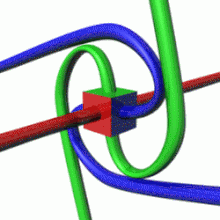The tornado analogy is great (no maths - woot), but tornadoes always spin in the plane of travel. Would this also apply to particles. If not, the particle spin speed would not add to the travel speed if the two were at right-angles.
If the waves didn't stay in the general vicinity of a single point would you call them particles

Going back to meteorology example there is no difference between a high or low pressure cell, a hurricane and a tornado.
What is different is the size and energy of the wave relative to the human perspective. Saying something isn't spinning
with the plane of travel can be very tricky look at space orbits as another example.
Particles will tend to go for volumes of spin not planes think about the uncertainty principle.
What becomes important in defining a particle or a tornado is the human perspective. That is why the mathematics of
class 1 is so hard it describes things on vastly different scales and there isn't a definitive cutoff that this is a particle
and this isn't, deciding when something is a tornado can be equally tricky. I imagine like physicists there is some sort
of rules a meteorologist uses.
What we end up doing is defining both relative to how we generally encounter them in our normal enviroment.
All that ends up with particles being quantum waves holding proximity to a point, which we then call Quantum spin.
You need to however have in the back of your mind the definition of a particle isn't a hard science definition

Finally we need to deal with the fact when we are at the speed of light spin itself takes on a weird form and look
because of relativity which Paul Dirac solved in 1928 when he converted the class 1 classical equations in relativistic
ones (
https://en.wikipedia.org/wiki/Relativistic_wave_equations)
Here is the usual visualization

After a 360 degree rotation, the spiral flips between clockwise and counterclockwise orientations.
It returns to its original configuration after spinning a full 720 degrees. So one rotation is only half a spin of the fields.
Notice none of the fields cross themselves or any other field.
If you are really observant you will also notice there are two spins as drawn one of the classical orbital
angular momentum kind of the box itself in the middle and one of the fields which can only be described easily by
equations. The situation is correct in Quantum mechanics both spins can be present.




